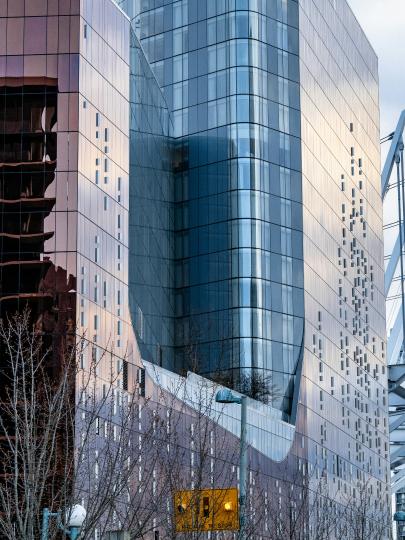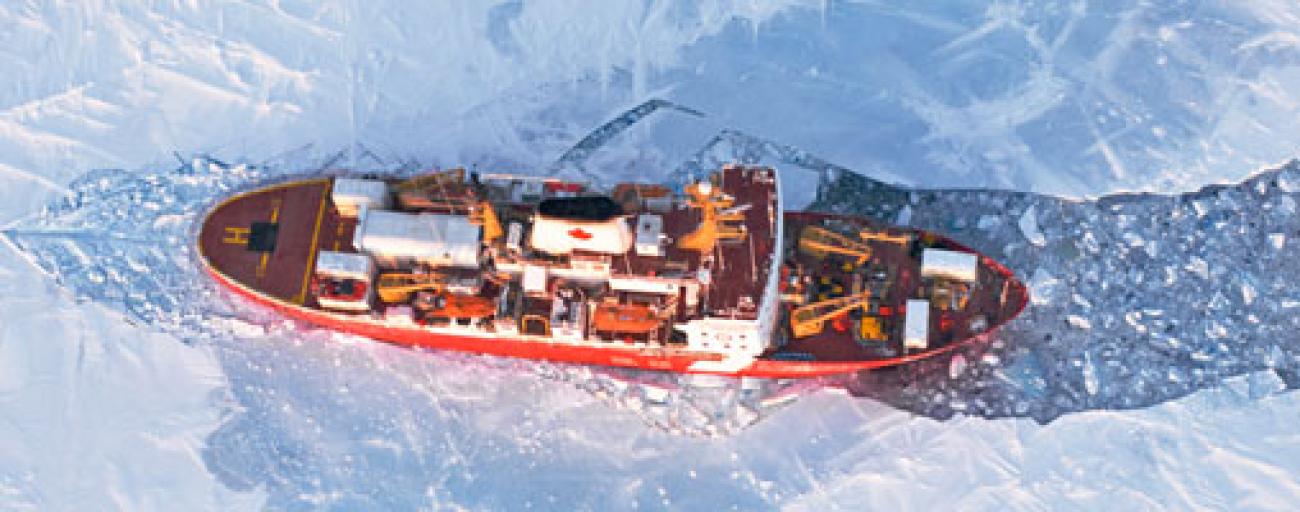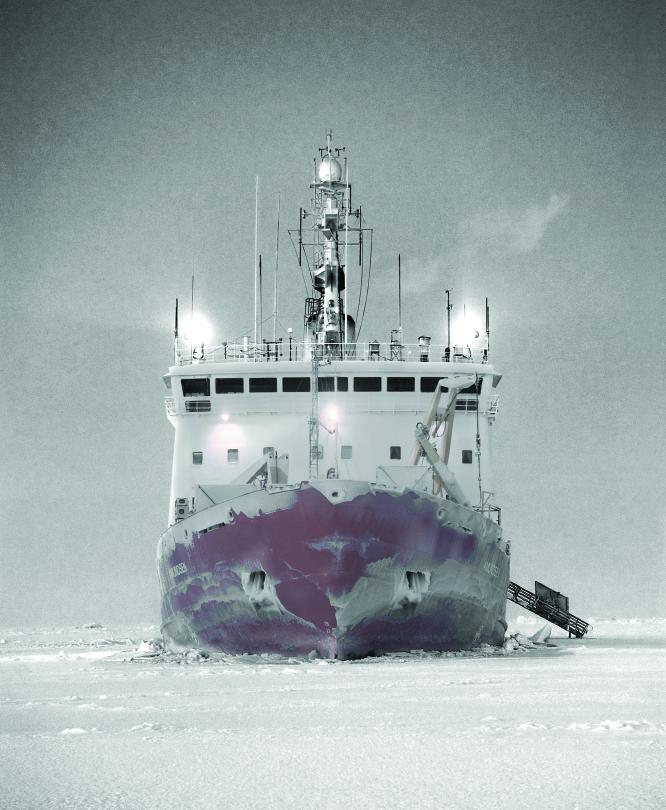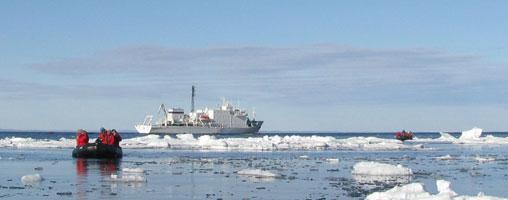Letter from the Arctic
Pond Inlet, the “Switzerland of the Arctic,” is situated at the northern end of Baffin Island. Its mostly Inuit residents, their colourful houses almost touching the dark waters of Eclipse Sound, look out at the ice-capped mountains and glacier-filled valleys of Bylot Island’s Sirmilik National Park.
Eclipse Sound itself is littered with icebergs, which calve off glaciers as they move towards the sea. One particularly handsome specimen is lodged on the bottom just offshore the hamlet; its pinnacle stretches 50 metres high.
Climate change has made Pond Inlet a busy place, full of tourists, prospectors, scientists and bureaucrats. I’ve arrived on a chartered flight from Iqaluit, 1000 kilometres to the south. There are two other big planes already parked on the small gravel apron, along with two smaller turboprops and a pair of helicopters. Together, the seven aircraft could hold 200 people; the tiny terminal, in contrast, has seats for just 10.
It’s busy offshore, too. The Canadian Coast Guard icebreaker Amundsen is anchored alongside a 20-metre motor yacht and a 10-metre sailboat. As we swoop overhead, the Amundsen’s helicopter pilot tells me that the sailboat is from Australia. Its owners have come to sail the Northwest Passage. Later this summer, we might have to rescue them.
The Amundsen has rescued tourists before. Last summer a Yugoslavian-built ice-strengthened cruise ship, the Clipper Adventurer, struck an underwater ledge in Coronation Gulf, 1500 kilometers southwest of here. Fortunately, the seas were calm and the Coast Guard was just two days sailing time away. Had the weather been worse – and it usually is in the Arctic – hundreds of lives might have been lost.
Just last week, two Inuit hunters died near the hamlet of Arctic Bay after their six-metre boat overturned in five-metre waves.
For this reason, our arrival on the Amundsen’s flight deck is followed by an hour-long safety course. At one point, we have to strap ourselves into one of the enclosed lifeboats. I’m seated beside Julie Payette, the Canadian astronaut, who smiles at my visible nervousness in that tightly confined space. “Don’t worry,” she smiles, “help will arrive within a week.”
Although lifesaving takes priority, the Amundsen’s principal mission is science. In a unique partnership with ArcticNet, a federally funded consortium of researchers from 29 Canadian universities, the Coast Guard vessel provides a mobile platform for the collection of data and samples. As we sail towards Lancaster Sound, we’re constantly measuring the environment, mapping the bottom with sonar, slowing down to trawl for plankton and fish larvae, and stopping periodically to collect water and seabed sediments. We even have a small, remote-controlled submarine on board, which is deployed through a “moon pool” on the underside of the ship.
Tomorrow, we’ll be looking for sea-ice, and particularly “multi-year ice.” This is ice that forms on the surface of the ocean during the winter months and survives the following summer’s melt to become much thicker and harder. It is this ice that provides the best habitat for seals, narwhales, belugas and polar bears. It is this ice that keeps foreign vessels from entering the Northwest Passage and challenging Canada’s sovereignty claim. And it is this ice that is disappearing at a phenomenal rate, as rising air and water temperatures melt it from above and beneath.
The VIPs on board – Payette, former French Prime Minister Michel Rocard, British High Commissioner Andrew Pocock – are hoping to see a polar bear. These “charismatic carnivores” stand more than three meters high and weigh
up to 600 kilograms. Seemingly invincible, the bears are threatened with extinction by the rapidly melting of the ice. As their scientific name ursus maritimus indicates, polar bears are a sea-going species that has evolved specifically to hunt ringed seals on ice. The bears can survive on land for months at a time, but they need to catch seals to build up the vast fat stores that enable them to nurse their young. The ringed seals also need ice, as do the Arctic cod on which the seals feed, and the plankton the cod eat.
Every visitor to the Arctic becomes acutely aware of two things: the raw, awesome beauty of this place; and the fact that climate change is advancing much more quickly than many people in the “South” would believe.
What responsibility do we, the human species, have to the Arctic? Is the planet ours to exploit, to alter irreversibly?
It’s “bar night” on the Amundsen, but I’m feeling too meditative to join in the singing. I retire to the top deck and watch the midnight sun play across the water, snow and ice. Then, I hear it – the ice-cube cracking in my drink. Chipped off an iceberg earlier today, the ancient ice is releasing molecules of atmosphere into my drink. Molecules that might have been locked inside a glacier since before modern man (homo sapiens) appeared on Earth.
UBC Travel Program: Canada's Northwest Passage
This summer, 41 UBC alumni and friends participated in expeditions to the Canadian Arctic and the legendary Northwest Passage. Presentations, conversations and learning accompanied their exploration of the great outdoors aboard the Russian-flagged Akademik Ioffe, designed and built in Finland as a scientific research vessel in 1989. Experts on board presented on topics including climate change, wildlife, Inuit culture and history, and early European explorers. Here are some highlights from both legs of the voyage.
Canada’s Northwest Passage
UBC Alumni Travel Program
COMPILED FROM THE DAILY OCEAN NOTES PROVIDED TO TRAVELLERS, AND PERSONAL OBSERVATIONS FROM UBC TRIP HOST KAREN KANIGAN. PHOTOS: KAREN KANIGAN AND FELLOW PASSENGERS.
Westward Voyage (Resolute to Kugluktuk): August 15-29
Eastward Voyage (Kugluktuk to Iqaluit): August 27-September 10
This summer, 41 UBC alumni and friends participated in expeditions to the Canadian Arctic and the legendary Northwest Passage. Presentations, conversations and learning accompanied their exploration of the great outdoors aboard the Russian-flagged Akademik Ioffe, designed and built in Finland as a scientific research vessel in 1989. Her bridge was open to passengers virtually 24 hours a day. Experts on board presented on topics including climate change, wildlife, Inuit culture and history, and early European explorers. UBC professor Michael Byers presented on the issue of Arctic sovereignty, a growing cause of debate as ice melts, new shipping routes open, and natural resources become accessible. Recommended pre-trip reading was late UBC alumnus Pierre Berton’s book, The Arctic Grail. Here are some highlights from both legs of the voyage.
Communities Meet
We were the first tourists to spend time in the hamlet of Igloolik all summer, and it seemed as if everyone living there came out to meet us at the landing, including dozens of kids who had a blast hanging out in the Zodiacs and sharing stories with us. We compared different forms of wet skins, theirs being the natural variety and ours being bright red high-tech expedition gear. We were greeted with bannock and tea, shook hands with the elders and enjoyed dancing, singing and watching artisans work on their carving and screen-printing. We explored on foot and by van, and some hitched rides on the all-terrain vehicles used to get around by most people living there.
Exploring Historical Sites
Abandoned Hudson’s Bay posts, and the Cold War radar stations that formed a DEW line (Distance Early Warning), are remnants of our not-too-distant past. Our guides also pointed out what they believed to be ancient Inuit sites – uninhabited, but still used as hunting camps – with their telltale inukshuks, caribou bones, and sources of fresh water and berries. A highlight of the western leg was tracing Franklin’s last voyage, gazing out across the sea and land towards the final resting place of his crew. From the gravesites on Beechey Island to the cairn marking their last know location, each historical site brought an increasing appreciation of the despair faced by these unfortunate explorers.
Wildlife Watch
Muskoxen: Once threatened by overhunting, muskoxen have rebounded in recent decades and are again expanding into former ranges. Populations have increased dramatically on Banks and Victoria islands, hence the numbers of muskoxen hides seen in Cambridge Bay. The small herd we saw in Johansen Bay is typical of summer. One dominant bull is controlling the herd’s movements and following the females, checking their reproductive status. The calves and yearlings spend much time at play, “rehearsing” the aggressive behaviour of adult bulls by head-butting and chasing each other around the herd.
Bowhead Whales: Shortly after breakfast one day, the Loffe found itself in the midst of a pod of elusive Bowhead whales, and the count was on. Even veteran polar naturalist Tony Soper could not believe his eyes as it went into double digits. The final number was 71.
… and bears, oh my: As if three polar bears and three gyrfalcons at Beechey Island one morning were not enough, we also experienced a spectacular seabird feeding-frenzy the same afternoon. Thousands of northern fulmars and hundreds of black-legged kittiwakes and glaucous gulls were feeding voraciously on sea butterflies (a pelagic mollusk whose foot is transformed into wings) and Arctic cod. The frenzies were particularly animated each time the cod pushed the sea butterflies to the surface, where the hungry birds waited for both fish and mollusks. Harp seals also joined the fray and a hungry bear waited for a seal to swim close to the beach. From mollusks to bear, the entire arctic food chain was on display.
Observing Climate Change
The ice is very nearly gone. Spending time in a place of such breathtaking natural beauty and wildlife, and realizing this trip may not have been navigable until recent years, made for many moments of silence and contemplation. We rarely saw an iceberg — the captain and expedition leader would review ice charts regularly in an effort to either track some down, or avoid dangerous encounters. In the end, we were fortunate to have one full day of “ice time,” reaching it by Zodiac or kayak.
What’s Next:
Onward to Newfoundland, Labrador and Baffin Island (July 2012); and Antarctica (February 2013).
Contact Karen Kanigan (karen.kanigan@ubc.ca / 604.822.9629 / toll free: 800.883.3088) or our travel partners, Worldwide Quest (www.worldwidequest.com) with questions or for more information.
































